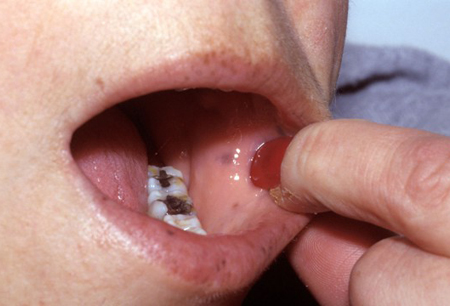History and exam
Key diagnostic factors
common
presence of risk factors
Key risk factors include presence of a germline STK11 gene mutation and a family history of PJS.
small intestinal obstruction
mucocutaneous pigmentation
Present in about 95% of cases.[15] Occurs most commonly on the vermillion border of the lips (94%), buccal mucosa (66%), hands (74%), and feet (62%), but has also been reported in the peri-orbital, peri-anal, and genital areas.[15]
Typically manifests as small, dark brown or blue-brown macules in infancy that may fade in late adolescence. The buccal lesions usually persist.[13][Figure caption and citation for the preceding image starts]: Characteristic pigmentation present on lips and buccal mucosaFrom the collection of Dr Carol A. Burke, used with permission [Citation ends].
Other diagnostic factors
common
abdominal discomfort and distension
Abdominal discomfort and distension are common symptoms of PJS. Polyp growth begins in childhood by age 10 years, with most experiencing symptoms such as bleeding, abdominal pain, intussusception, or obstruction by age 18 years.[14]
uncommon
gastrointestinal bleeding
polyp prolapse per anus
Presenting complaint in 7% of patients.[15]
enlarged testicles (without masses)
May suggest an underlying testicular tumour. Boys with PJS are at risk for Sertoli cell tumours that can cause gynaecomastia and other signs of hyperoestrogenism and occasionally virilisation and/or accelerated height growth.[14] The average age of diagnosis for testicular cancer is 9 years, with a range of 3 to 20 years.[16]
bilateral gynaecomastia
May suggest an underlying Sertoli cell tumour.
fatigue
Due to anaemia with colonic polyps.
pallor
Due to anaemia with colonic polyps.
Risk factors
strong
positive family history
PJS is inherited in an autosomal-dominant fashion in most patients. Each child of an affected parent has a 50% chance of inheriting PJS. Approximately 25% of newly diagnosed PJS patients represent de novo mutations.[4]
Use of this content is subject to our disclaimer